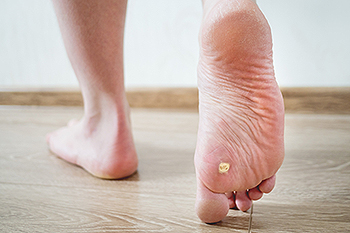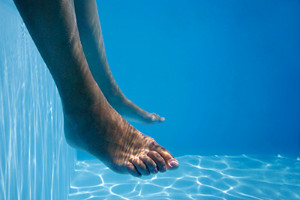Connect With Us
Blog
Items filtered by date: December 2022
Surgery for Morton’s Neuroma

Morton’s neuroma is the thickening and hardening of the nerve cells in the foot. It most often affects the third and fourth toes. This condition is caused by repeated trauma or injury to the foot, shoes that do not fit well, wearing high heels, or foot abnormalities, such as flat feet or high arches. With Morton’s neuroma, one can experience pain, swelling, numbness, tingling, and burning in the ball of the foot and radiating out to the toes. Some describe the sensation as walking on a pebble. Rest, properly fitting shoes, and a cushioned shoe pad can help when one has a Morton’s neuroma. When more conservative treatment is unsuccessful, surgery to space tissue around the nerve or excise the neuroma can be considered. While such surgery is usually successful in resolving pain, it can lead to numbness in the affected area. There is also a chance a Morton’s neuroma will come back. If you are suffering from a Morton’s neuroma, seeking treatment from a podiatrist to try and deal with the problem before surgery is the most viable option.
Morton’s neuroma is a very uncomfortable condition to live with. If you think you have Morton’s neuroma, contact one of our podiatrists of Foot and Ankle Center. Our doctors will attend to all of your foot care needs and answer any of your related questions.
Morton’s Neuroma
Morton's neuroma is a painful foot condition that commonly affects the areas between the second and third or third and fourth toe, although other areas of the foot are also susceptible. Morton’s neuroma is caused by an inflamed nerve in the foot that is being squeezed and aggravated by surrounding bones.
What Increases the Chances of Having Morton’s Neuroma?
- Ill-fitting high heels or shoes that add pressure to the toe or foot
- Jogging, running or any sport that involves constant impact to the foot
- Flat feet, bunions, and any other foot deformities
Morton’s neuroma is a very treatable condition. Orthotics and shoe inserts can often be used to alleviate the pain on the forefront of the feet. In more severe cases, corticosteroids can also be prescribed. In order to figure out the best treatment for your neuroma, it’s recommended to seek the care of a podiatrist who can diagnose your condition and provide different treatment options.
If you have any questions, please feel free to contact our office located in Egg Harbor Township, NJ . We offer the newest diagnostic and treatment technologies for all your foot care needs.
Running May Cause Toe Pain

People who enjoy running may notice that they have developed pain in their big toe. This pain can cause difficulty when walking or running and can occur for various reasons. These causes may include the amount of force the joints in the big toe endure while running, in addition to how the heel strikes the ground. This can lead to your foot pronating, meaning the foot rolls inward to absorb the shock. This is followed by pushing off, and the weight of the body travels to the big toe. Some people may have bunions and they appear as a bony bump on the side of the big toe. Bunions often arise from wearing shoes that do not fit correctly. People who run can experience increased toe pain if they are afflicted with a bunion. It is suggested that the shoes worn fit correctly for the style of running that is desired, and this may help to reduce toe pain. If you would like more information about why toe pain occurs, in addition to learning about effective prevention methods, please consult with a podiatrist.
Toe pain can disrupt your daily activities. If you have any concerns, contact one of our podiatrists of Foot and Ankle Center. Our doctors can provide the care you need to keep you pain-free and on your feet.
What Causes Toe Pain?
Most severe toe pain is caused due to a sports injury, trauma from dropping something heavy on the toe, or bumping into something rigid. Other problems can develop over time for various reasons.
Toe pain can be caused by one or more ailments. The most common include:
- Trauma
- Sports injury
- Wearing shoes that are too tight
- Arthritis
- Gout
- Corns and calluses
- Hammertoe
- Bunions
- Blisters
- Ingrown toenails
- Sprains
- Fractures (broken bones)
- Dislocations
When to See a Podiatrist
- Severe pain
- Persistent pain that lasts more than a week
- Signs of infection
- Continued swelling
- Pain that prevents walking
Diagnosis
In many cases the cause of toe pain is obvious, but in others, a podiatrist may want to use more advanced methods to determine the problem. These can range from simple visual inspections and sensation tests to X-rays and MRI scans. Prior medical history, family medical history, and any recent physical traumatic events will all be taken into consideration for a proper diagnosis.
Treatment
Treatments for toe pain and injuries vary and may include shoe inserts, padding, taping, medicines, injections, and in some cases, surgery. If you believe that you have broken a toe, please see a podiatrist as soon as possible.
If you have any questions please feel free to contact our office located in Egg Harbor Township, NJ . We offer the newest diagnostic tools and technology to treat your foot and ankle needs.
Wounds That Don't Heal Need to Be Checked
Some Children May Be Prone to Plantar Warts

One ailment that can affect children is plantar warts. They are warts that develop on the bottom of the foot due to the pressure the foot endures while walking or running. These types of warts can cause extreme pain and discomfort and may disrupt the ability to run and play. Children may tell their parents that they feel like they are stepping on a small stone and the wart may have the appearance of a cauliflower with black veins in the center. These warts are contagious and the fungus that causes them lives in specific environments. These can include public swimming pools, locker rooms, and shower room floors so it is suggested that children wear appropriate shoes while in these areas. The fungus enters the body through small cracks on the skin and it is beneficial to refrain from sharing towels, shoes, and socks. Children with a weakened immune system may be susceptible to developing a plantar wart. This type of wart can be removed or treated by a podiatrist, so it is suggested that you schedule an appointment if your child is afflicted with this condition.
Plantar warts can be very uncomfortable. If you need your feet checked, contact one of our podiatrists from Foot and Ankle Center. Our doctors will assist you with all of your foot and ankle needs.
About Plantar Warts
Plantar warts are the result of HPV, or human papillomavirus, getting into open wounds on the feet. They are mostly found on the heels or balls of the feet.
While plantar warts are generally harmless, those experiencing excessive pain or those suffering from diabetes or a compromised immune system require immediate medical care. Plantar warts are easily diagnosed, usually through scraping off a bit of rough skin or by getting a biopsy.
Symptoms
- Lesions on the bottom of your feet, usually rough and grainy
- Hard or thick callused spots
- Wart seeds, which are small clotted blood vessels that look like little black spots
- Pain, discomfort, or tenderness of your feet when walking or standing
Treatment
- Freezing
- Electric tool removal
- Laser Treatment
- Topical Creams (prescription only)
- Over-the-counter medications
To help prevent developing plantar warts, avoid walking barefoot over abrasive surfaces that can cause cuts or wounds for HPV to get into. Avoiding direct contact with other warts, as well as not picking or rubbing existing warts, can help prevent the further spread of plantar warts. However, if you think you have developed plantar warts, speak to your podiatrist. He or she can diagnose the warts on your feet and recommend the appropriate treatment options.
If you have any questions please feel free to contact our office located in Egg Harbor Township, NJ . We offer the newest diagnostic and treatment technologies for all your foot and ankle needs.
Strengthening Ankles and Feet for Surfing

Surfing injuries commonly affect the ankles. Injuries due to surfing are often caused by forceful landings, particularly by new or competitive surfers practicing complex aerial maneuvers. To prevent such injuries, strengthening the feet and ankles is recommended. In addition to preventing injuries, strengthening the lower extremities will aid in improving overall surfing performance. Using a rail-to-rail surf balance board is a way of strengthening the ankles in a controlled way. Standing heel raises are an easy way to strengthen ankles and feet and can be done anywhere. Sand walking also can help increase strength for surfing. If you are a surfer and have sustained a foot or ankle injury or want additional suggestions for preventing such harm, consult with a podiatrist today.
Ankle and foot injuries are common among athletes and in many sports. They can be caused by several problems and may be potentially serious. If you are feeling pain or think you were injured in a sporting event or when exercising, consult with one of our podiatrists from Foot and Ankle Center. Our doctors will assess your condition and provide you with quality foot and ankle treatment.
Common Injuries
The most common injuries that occur in sporting activities include:
- Achilles Tendonitis
- Achilles Tendon Rupture
- Ankle Sprains
- Broken Foot
- Plantar Fasciitis
- Stress Fractures
- Turf Toe
Symptoms
Symptoms vary depending upon the injury and in some cases, there may be no symptoms at all. However, in most cases, some form of symptom is experienced. Pain, aching, burning, bruising, tenderness, tightness or stiffness, sensation loss, difficulty moving, and swelling are the most common symptoms.
Treatment
Just as symptoms vary depending upon the injury, so do treatment options. A common treatment method is known as the RICE method. This method involves rest, applying ice, compression and elevating the afflicted foot or ankle. If the injury appears to be more serious, surgery might be required, such as arthroscopic or reconstructive surgery. Lastly, rehabilitation or therapy might be needed to gain full functionality in the afflicted area. Any discomfort experienced by an athlete must be evaluated by a licensed, reputable medical professional.
If you have any questions, please feel free to contact our office located in Egg Harbor Township, NJ . We offer the newest diagnostic and treatment technologies for all your foot care needs.

